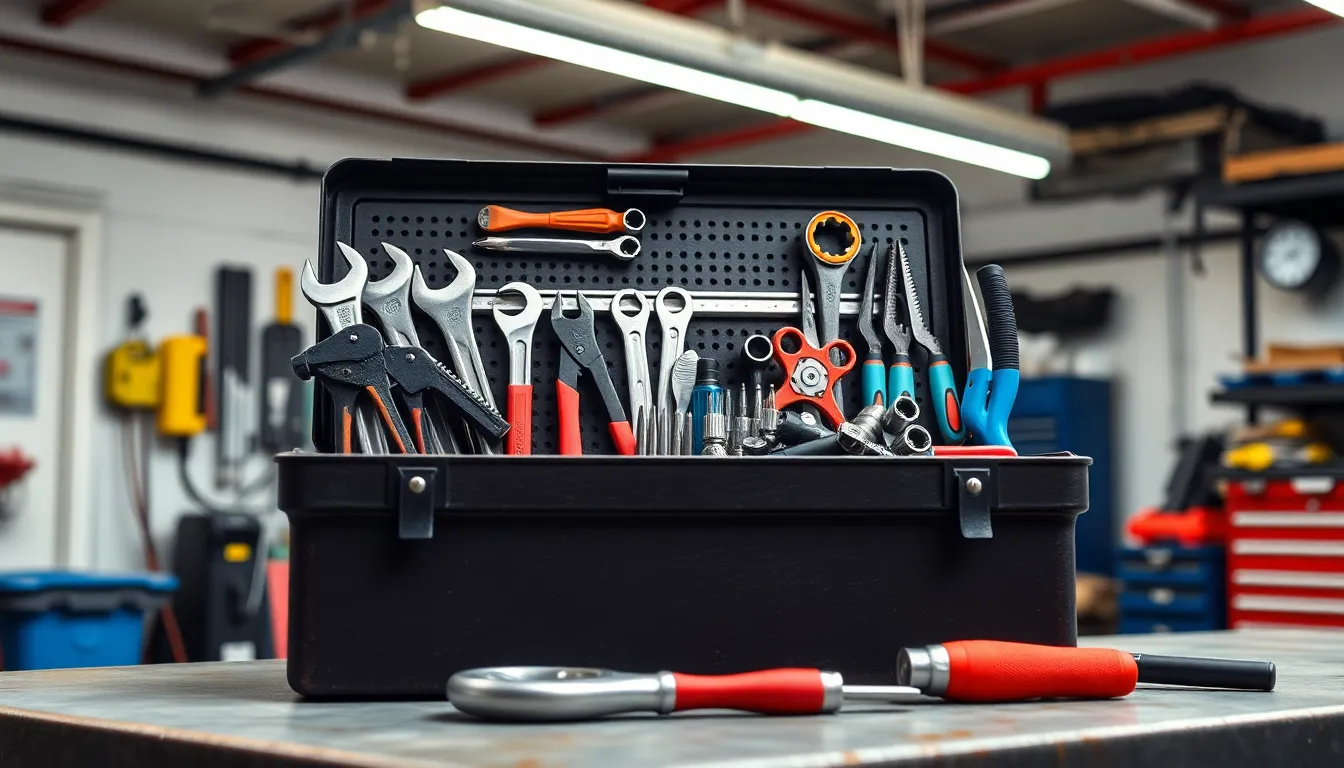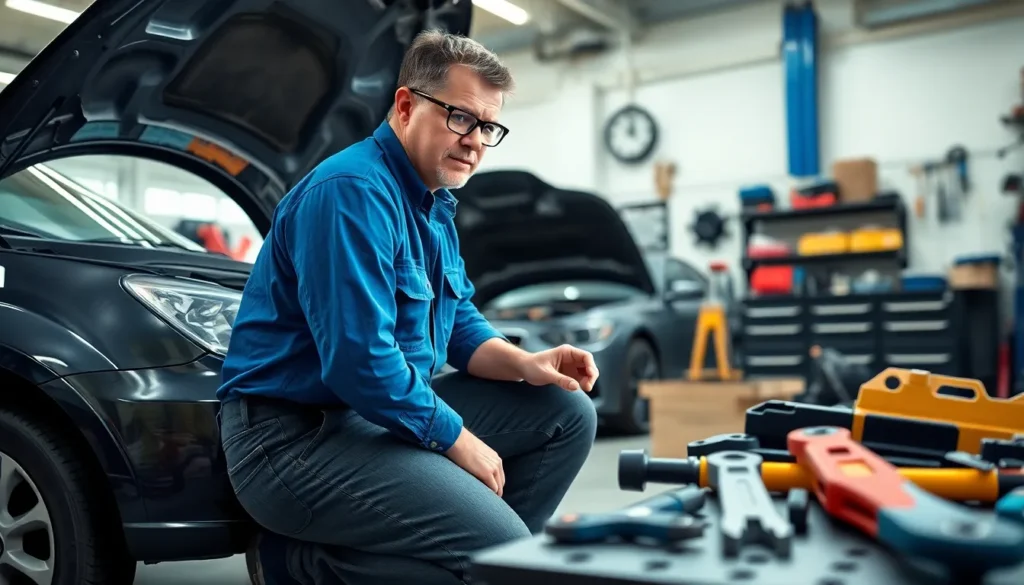Table of Contents
ToggleEvery car owner knows the dread that washes over them when the check engine light flickers on like an unwanted disco ball. Panic sets in as visions of costly repairs dance in their heads. But fear not! Fixing your car doesn’t have to feel like deciphering hieroglyphics or calling in a priest for an exorcism.
Understanding Common Car Problems
Common car problems often cause concern for car owners. Identifying these issues helps simplify the repair process.
Engine Issues
Engine issues frequently manifest as unusual noises or decreased performance. Overheating represents a common engine problem, often linked to coolant leaks or faulty thermostats. Worn spark plugs can lead to misfires, affecting acceleration. An oil change every 3,000 to 5,000 miles helps prevent oil sludge buildup. Regular inspections can identify issues early, reducing costly repairs.
Electrical System Failures
Electrical system failures can disrupt various vehicle functions. A dead battery often leads to starting problems, especially in cold weather. Faulty alternators may not charge batteries properly, causing failures. Fuses blow when there’s an overload, stopping essential systems from functioning. Checking wiring for damage or corrosion helps maintain electrical integrity. Regular battery checks improve reliability, preventing unexpected breakdowns.
Basic Tools You Need

Having the right tools is crucial for effective car repairs. A well-equipped toolbox simplifies the process, making it manageable for any car owner.
Essential Hand Tools
Wrenches come in various sizes, allowing for loosening and tightening bolts. Pliers are versatile tools, useful for gripping small objects or cutting wires. A socket set provides deep reach for fasteners in tight spaces. Screwdrivers, both flat-head and Phillips, assist in securing or removing screws. A jack and jack stands support the vehicle, providing safe access to underneath. These essential tools cover most basic repair tasks, equipping car owners for common fixes.
Diagnostic Equipment
An OBD-II scanner quickly identifies diagnostic trouble codes, offering insight into engine issues. A multimeter measures voltage, current, and resistance, useful for electrical system diagnostics. Tire pressure gauges ensure tires are inflated to recommended levels, promoting safety and efficiency. Compression testers evaluate engine health, providing data on cylinder pressure. Basic diagnostic equipment saves time, allowing for targeted repairs and avoiding unnecessary part replacements.
Step-by-Step Guide to Fix Common Issues
Car issues often arise unexpectedly. Being equipped with the knowledge to address these problems can enhance vehicle maintenance and prevent breakdowns.
Fixing a Flat Tire
Fixing a flat tire requires specific steps. First, gather necessary tools like a jack, lug wrench, and spare tire. Next, ensure the car is on a flat surface for stability. Loosen the lug nuts before raising the vehicle with the jack. Once lifted, remove the flat tire and replace it with the spare. After securing the spare, tighten the lug nuts and lower the car back to the ground. Lastly, make sure all lug nuts are properly tightened. Regularly inspect tire pressure, and rotating tires extends their lifespan.
Jumpstarting a Dead Battery
Jumpstarting a dead battery is straightforward. First, connect jumper cables to the dead battery, ensuring the red clamp attaches to the positive terminal and the black clamp to a safe ground. Next, connect the other end of the cables to a functioning battery in a separate vehicle. Start the functioning vehicle and let it run for a few minutes. Then, try to start the dead car while ensuring cables remain connected. After a successful start, carefully remove the cables in the reverse order. Regular battery maintenance, including checking connections and cleaning terminals, helps prevent unexpected failures.
When to Seek Professional Help
Car owners face situations where seeking professional help becomes essential. Unusual engine noises or persistent overheating signals underlying issues. Ignoring these symptoms can lead to more significant damage, so timely action is crucial.
Problems with electrical systems often require expert intervention. If a vehicle’s electrical components malfunction continually, it may suggest deeper issues not easily identified through basic diagnostics.
In cases of major accidents or structural damage, consulting a professional is necessary. Bodywork repairs can be complex, and skilled technicians possess the expertise to restore safety and aesthetics.
Engine misfires or warning lights on the dashboard necessitate immediate attention. Diagnosing these concerns can involve intricate processes beyond simple repairs, requiring specialized tools and knowledge.
Unfamiliarity with complex systems also indicates a need for expert assistance. If a car owner encounters difficulties with brake systems or transmission performance, turning to a mechanic ensures accurate assessments and repairs.
Before starting extensive repairs, assessing mechanical knowledge is smart. When a car owner feels overwhelmed or uncertain, professional mechanics can provide helpful insights and reliable solutions.
Understanding personal limits in repair skills fosters proactive decision-making. Prioritizing safety and vehicle reliability typically outweighs the initial costs of expert services. Doing so protects investments and maintains vehicle performance in the long run.
Taking charge of car repairs can be a rewarding experience for any vehicle owner. By understanding common issues and having the right tools on hand, they can tackle many problems with confidence. Regular maintenance and timely inspections play a crucial role in preventing costly repairs down the line.
While some tasks are manageable, knowing when to seek professional help is equally important. Recognizing limits ensures safety and vehicle reliability. With the right approach and knowledge, car owners can maintain their vehicles effectively while saving time and money. Embracing this proactive mindset not only enhances the driving experience but also fosters a deeper connection to their vehicle.







